Surface Properties of Ultrasonic Vibration-Assisted ELID Grinding ZTA Ceramics
Abstract
:1. Introduction
2. Surface Formation Mechanism of UVA-ELID Grinding
2.1. Kinematics Analysis of Grain
- (1)
- The surface of workpiece before and after processing was assumed to an ideal circular curved surface.
- (2)
- The abrasive particles were uniformly distributed on the grinding wheel, and its shape is an ideal spherical shape.
- (3)
- The contour of grains on the grinding wheel remained unchanged during processing due to the online electrolytic dressing of ELID.
- (4)
- The cutting trace of grains was circular, and the circular center of the cutting trace coincided with the center of the workpiece.
2.2. Critical Grinding Depth
3. Experimental Setup and Methodology
3.1. Experimental Setup
3.2. Experimental Condition
3.3. Surface Property Test
4. Results and Discussions
4.1. Surface Residual Stress
4.2. Surface Roughness
4.3. Surface Morphology
5. Conclusions
- (1)
- The trajectory of grains during the UVA-ELID displayed sinusoidal movement. The overlapping trajectory led to the surface microstructure more dense and uniform, presenting a reticulate microstructure. It was beneficial to reducing the surface roughness and improving the surface properties. In addition, the critical grinding depth during the UVA-ELID grinding was improved and the material removal was also changed.
- (2)
- The residual compressive stress was introduced into the surface during both processing. Under the action of ultrasonic vibration, the residual compressive stress increased by 42.1% compared with that during the C-ELID. During the UVA-ELID grinding, the high-frequency vibration could generate the reticulate microstructure on the surface. In addition, the surface roughness Ra and Rz decreased by 14.5% by 20.6%, respectively.
- (3)
- The characteristic of the nanocomposite ceramic changed during the UVA-ELID grinding, and the plastic removal occurred at the lower grinding depth. Therefore, the surface morphology was better with an increase in grinding depth.
Author Contributions
Funding
Institutional Review Board Statement
Informed Consent Statement
Data Availability Statement
Acknowledgments
Conflicts of Interest
References
- Chen, Y.P.; Cen, Y.K.; Liao, Y.M. A study on the mechanical properties and micro-structure of alumina-zirconia nano-composite infiltrated ceramic. West China J. Stomatol. 2003, 3, 238–240. [Google Scholar]
- Kitzig-Frank, H.; Tawakoli, T.; Azarhoushang, B. Material removal mechanism in ultrasonic-assisted grinding of Al2O3 by single-grain scratch test. Int. J. Adv. Manuf. Technol. 2017, 91, 2949–2962. [Google Scholar] [CrossRef]
- Gadow, R.; Kern, F.; Killinger, A. Manufacturing technologies for nanocomposite ceramic structural materials and coatings. Mater. Sci. Eng. B 2008, 148, 58–64. [Google Scholar] [CrossRef]
- Yu, Q.H.; Wang, J.Q.; Yin, Q.; Zheng, Y. Study on the preparation of zirconia toughened alumina composite ceramics by liquid-phase boating method. China Ceram. 2015, 51, 31–34. [Google Scholar]
- Li, D.F.; Sun, J.L. Investigation of the tribological behavior of zirconia toughened alumina sliding in air. Surf. Technol. 2003, 32, 15–19. [Google Scholar]
- Wang, C.; Zhao, F.; Han, Y.L. Distribution and fracture toughening mechanism of ZrO2 particles in ZrO2/Al2O3 ceramic. Chin. Ceram. 2014, 50, 22–24+28. [Google Scholar]
- Soh, A.K.; Fang, D.N.; Dong, Z.X. Analysis of toughening mechanisms of ZrO2/nano-SiC ceramic composites. J. Compos. Mater. 2004, 38, 227–241. [Google Scholar] [CrossRef]
- Wang, Y.T.; Zhou, X.P.; Kou, M. Numerical studies on thermal shock crack branching instability in brittle solids. Eng. Fract. Mech. 2018, 204, 157–184. [Google Scholar] [CrossRef]
- Zhong, Z.W.; Venkatesh, V.C. Recent developments in grinding of advanced materials. Int. J. Adv. Manuf. Technol. 2009, 41, 468–480. [Google Scholar] [CrossRef]
- Zhao, B.; Jia, X.F. Effects of processing parameters of oxide layer in ultrasonic vibration and electrolytic in-process dressing combined grinding. Adv. Mater. Res. 2014, 1027, 3–7. [Google Scholar] [CrossRef]
- Zhao, B.; Jia, X.F.; Chen, F.; Wang, X.B. Control model and the experimental study on the ultrasonic vibration-assisted electrolytic in-process dressing internal grinding. Int. J. Adv. Manuf. Technol. 2017, 92, 1277–1289. [Google Scholar] [CrossRef]
- Kwak, T.S.; Lee, Y.C.; Kim, G.N.; Choi, D.B.; Yamanoi, M.; Ohmori, H. Nano-precision combined process of electrolytic in-process dressing grinding and magnetic assisted polishing on optics glass material. Trans. Nonferrous Met. Soc. China 2009, 19, S301–S306. [Google Scholar] [CrossRef]
- Nebashi, N. In process truing/dressing of grinding wheels by WEDG and ELID. Int. J. Electr. Mach. 1998, 3, 33–38. [Google Scholar]
- Kwak, T.S.; Jung, M.W.; Kim, G.H.; Kwak, I.S. The effect of ultrasonic vibration table on ELID grinding process of aluminum nitride ceramics. J. Korean Soc. Precis. Eng. 2013, 30, 1237–1243. [Google Scholar] [CrossRef]
- Zhao, B.; Chen, F.; Jia, X.F.; Zhao, C.Y.; Wang, X.B. Surface quality prediction model of nano-composite ceramics in ultrasonic vibration-assisted ELID mirror grinding. J. Mech. Sci. Technol. 2017, 31, 1877–1884. [Google Scholar] [CrossRef]
- Chen, H.; Zhou, W.; Tang, J. An experimental study of the effects of ultrasonic vibration on grinding surface roughness of C45 carbon steel. Int. J. Adv. Manuf. Technol. 2013, 68, 2095–2098. [Google Scholar] [CrossRef]
- Chen, F. Mechanism Research on In-Process Dressing of Grinding Wheel in Ultrasound-Aided ELID Grinding. Ph.D. Thesis, Henan Polytechnic University, Jiaozuo, China, 2017. [Google Scholar]
- Swain, M.V.; Lawn, B.R. Indentation fracture in brittle rocks and glasses. Int. J. Rock. Mech. Min. 1976, 13, 311–319. [Google Scholar] [CrossRef]
- Wilshaw, T.R.; Rau, C.A.; Terelman, A.S. A general model to predict the elastic-plastic stress distribution and fracture strength of notched bars in plane strain bending. Eng. Fract. Mech. 1968, 1, 197–211. [Google Scholar] [CrossRef]
- Tong, J.L.; Chen, P.; Zhao, J.S.; Zhao, B. Fracture test of nanocomposite ceramics under ultrasonic vibration based on nonlocal theory. Ceram. Int. 2019, 45, 20945–20953. [Google Scholar] [CrossRef]
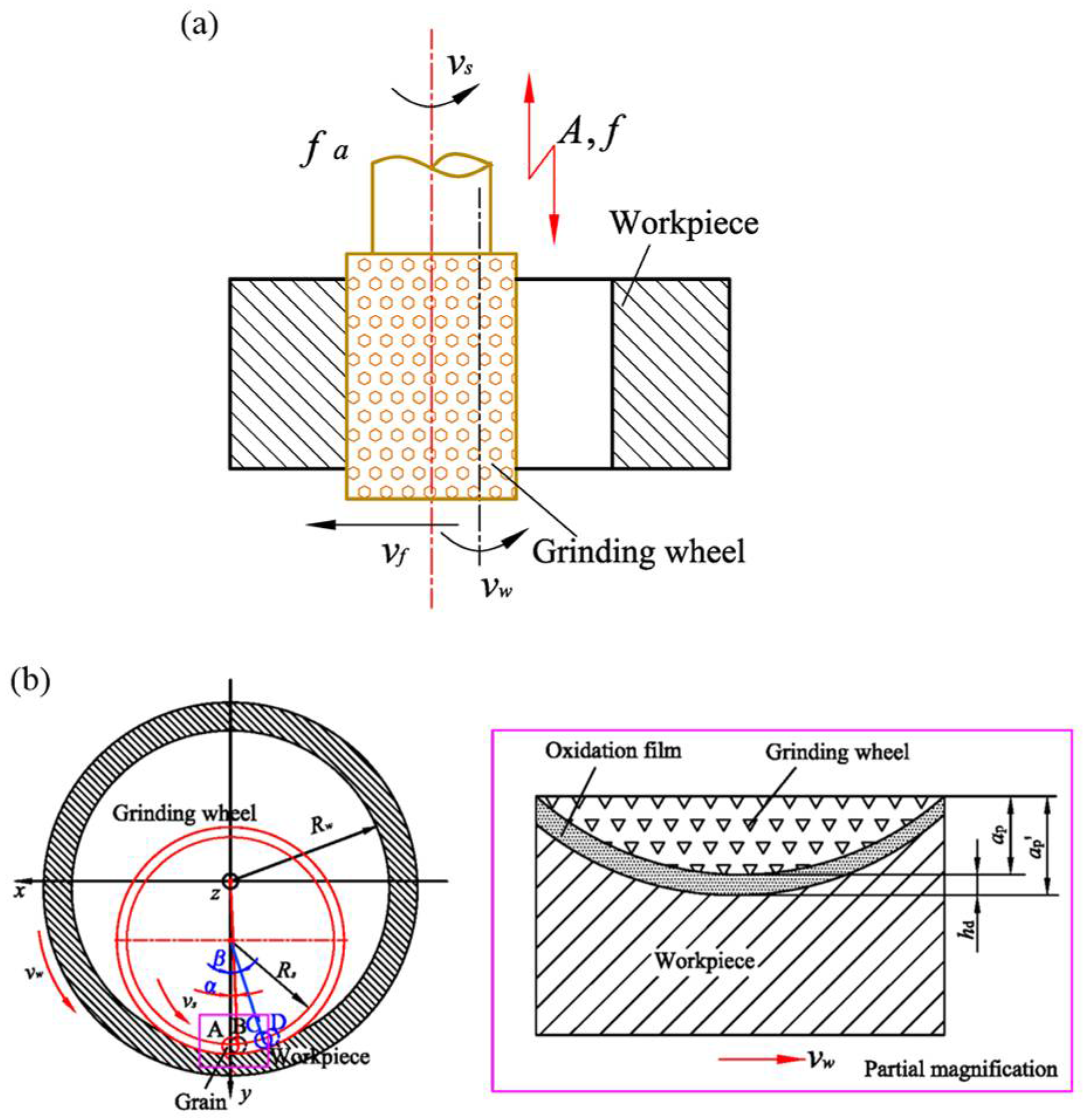

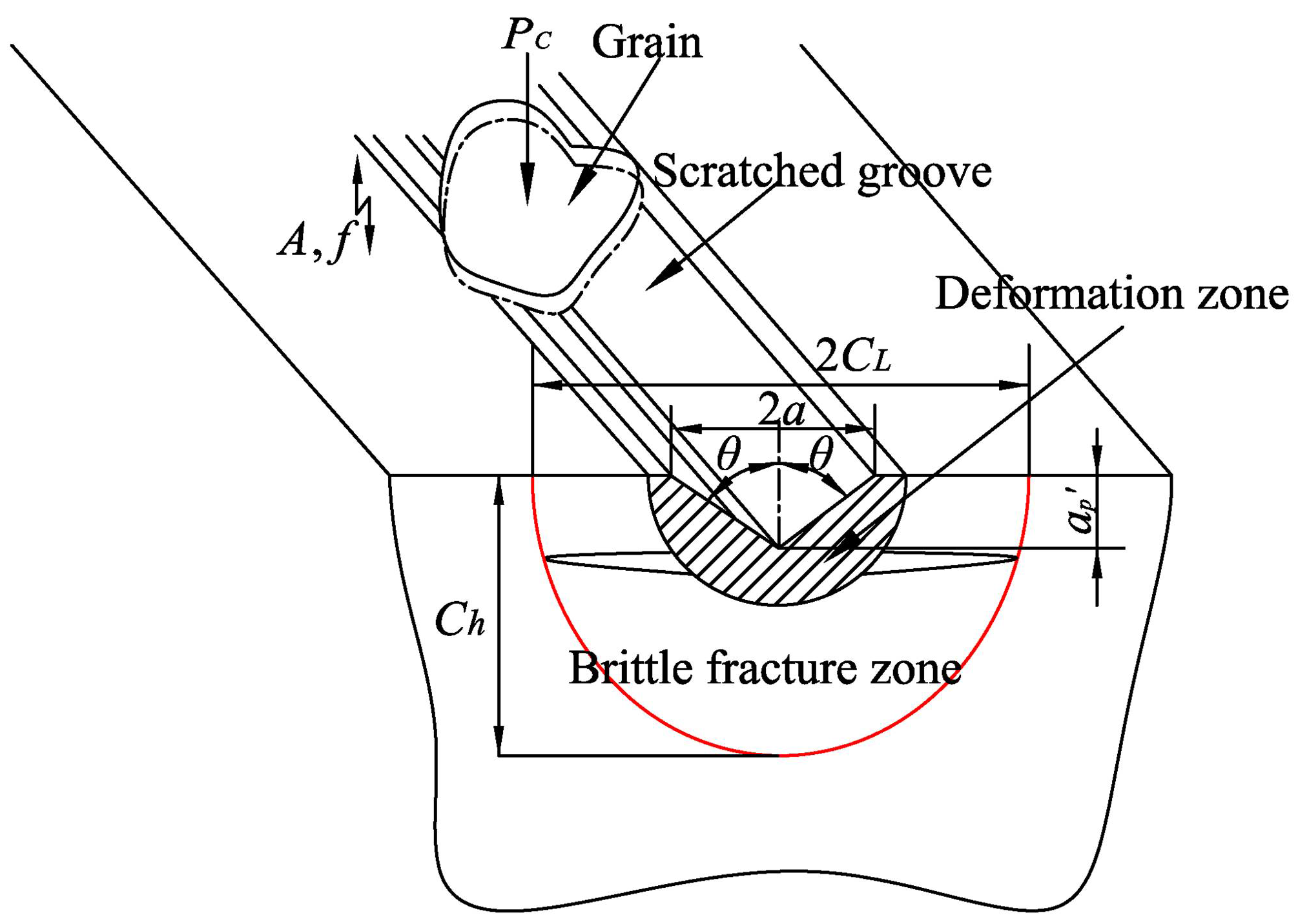
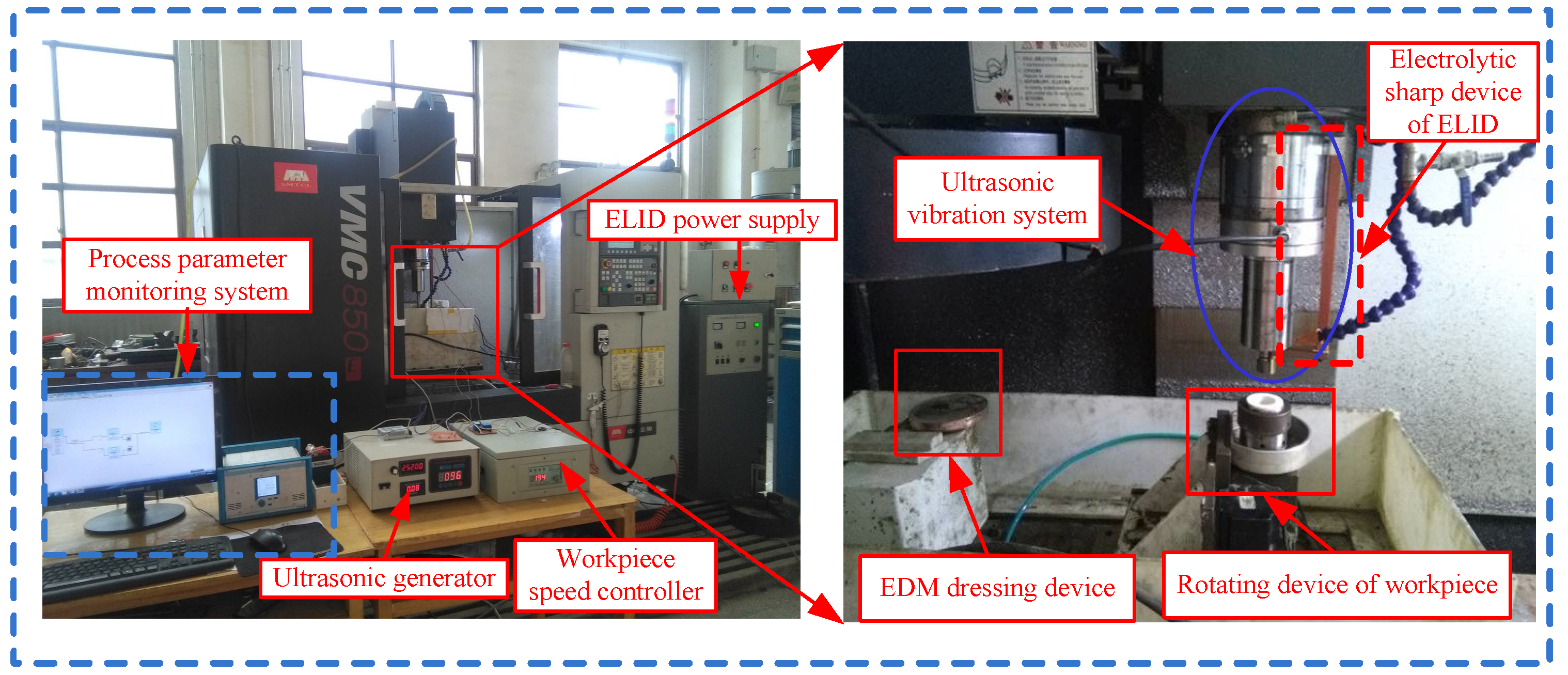
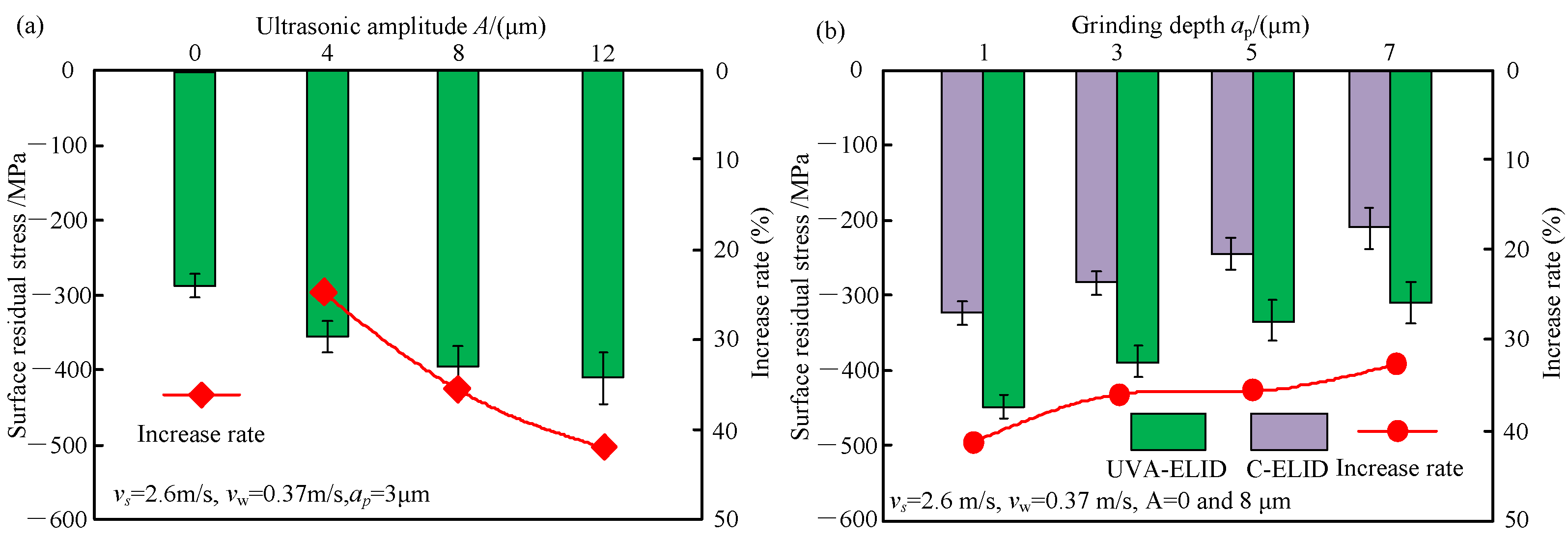


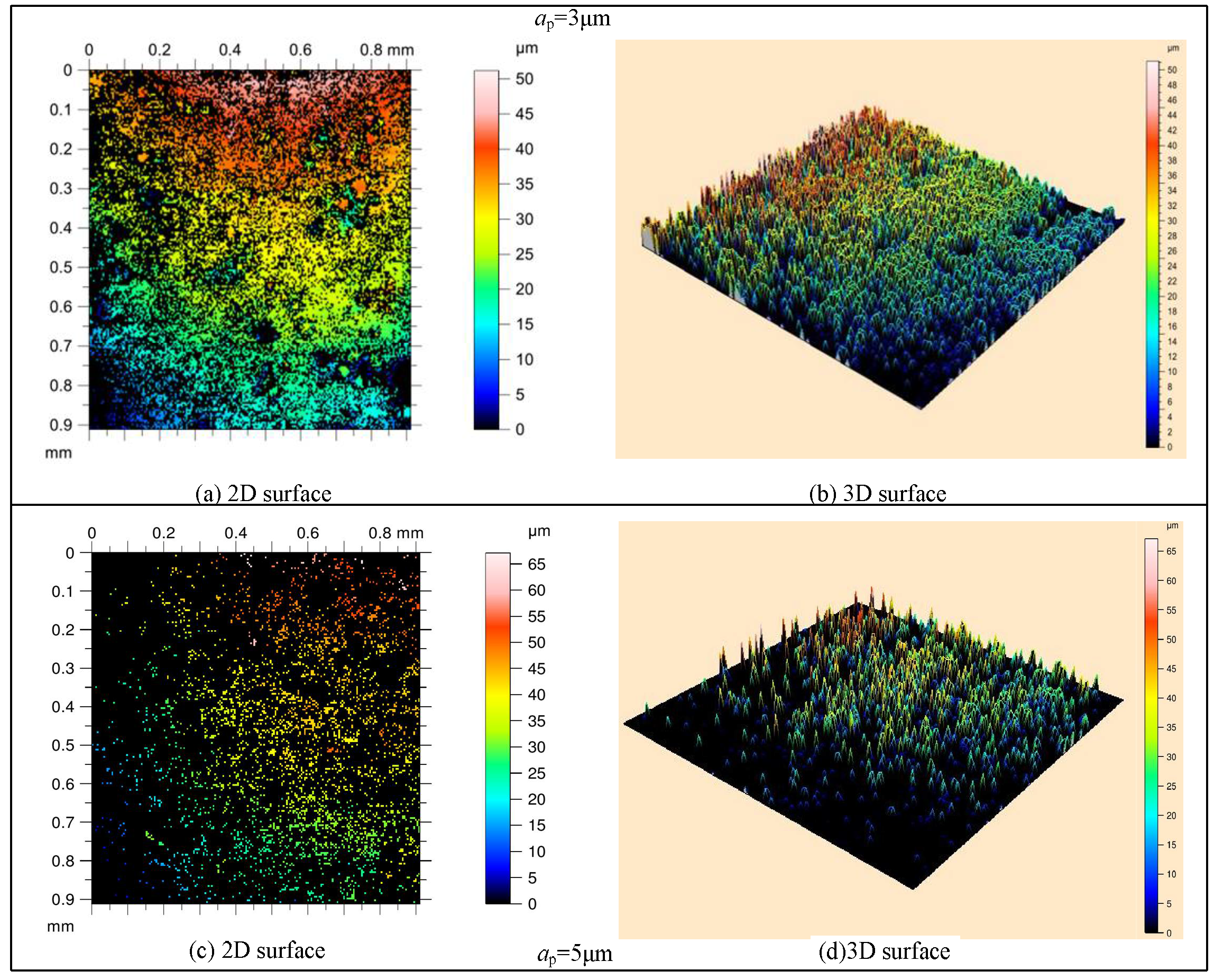
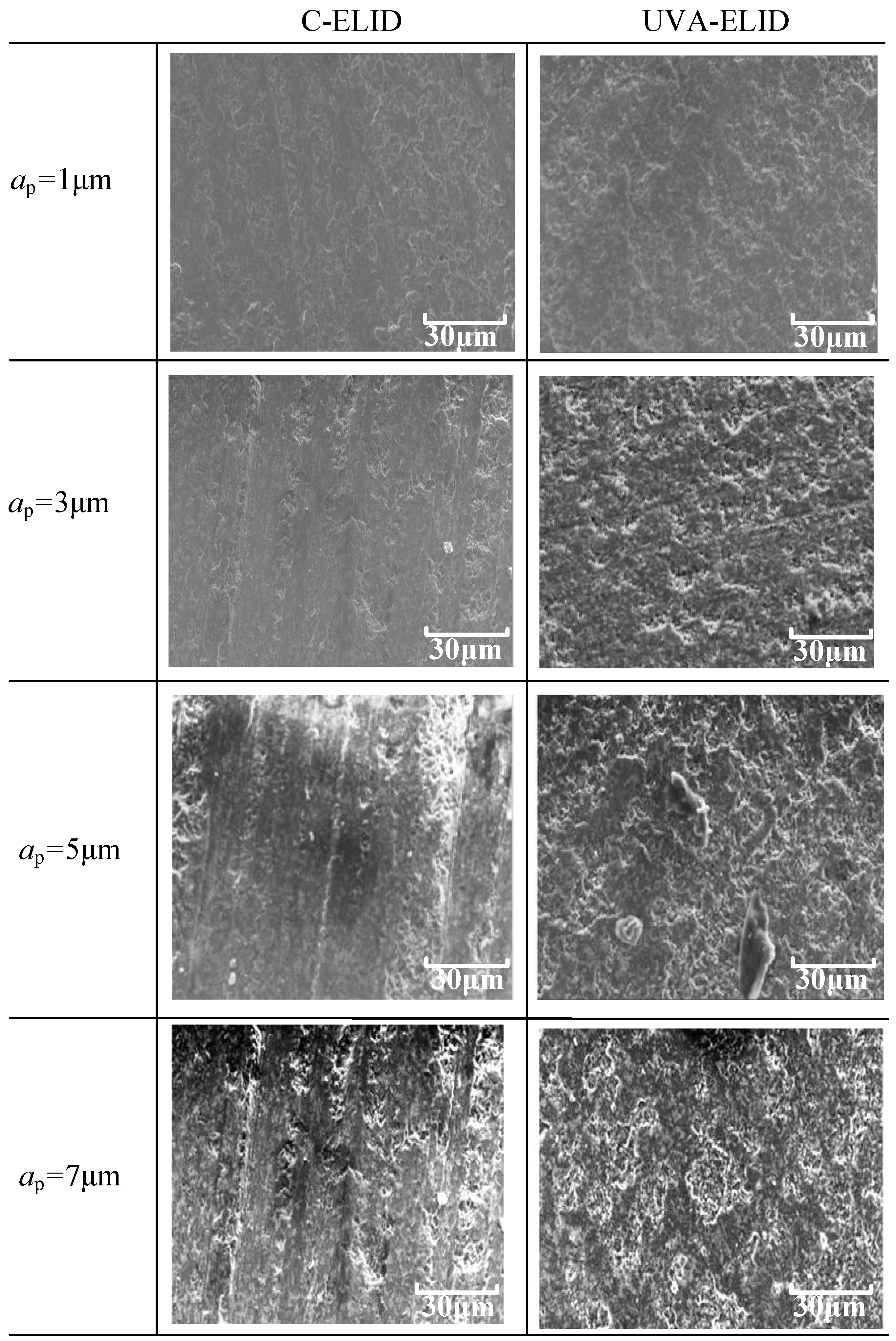
| Types | Parameters | Value |
|---|---|---|
| Trimming | Voltage (V) | 120 |
| Wheel speed (r/min) | 1000 | |
| Workpiece | Outer diameter (mm) | 60 |
| Inside diameter (mm) | 35 | |
| Height (mm) | 40 | |
| Grinding parameters | Wheel speed (m/s) | 2.6 |
| Grinding depth (μm/pass) | 1, 3, 5, 7 | |
| Workpiece speed(m/s) | 0.37 | |
| Ultrasonic parameters | Frequency (kHz) | 25.3 |
| Amplitude (μm) | 0, 4, 8, 12 |
Publisher’s Note: MDPI stays neutral with regard to jurisdictional claims in published maps and institutional affiliations. |
© 2022 by the authors. Licensee MDPI, Basel, Switzerland. This article is an open access article distributed under the terms and conditions of the Creative Commons Attribution (CC BY) license (https://creativecommons.org/licenses/by/4.0/).
Share and Cite
Fu, Z.; Chen, F.; Bie, W.; Zhao, B.; Wang, X. Surface Properties of Ultrasonic Vibration-Assisted ELID Grinding ZTA Ceramics. Materials 2022, 15, 636. https://doi.org/10.3390/ma15020636
Fu Z, Chen F, Bie W, Zhao B, Wang X. Surface Properties of Ultrasonic Vibration-Assisted ELID Grinding ZTA Ceramics. Materials. 2022; 15(2):636. https://doi.org/10.3390/ma15020636
Chicago/Turabian StyleFu, Zongxia, Fan Chen, Wenbo Bie, Bo Zhao, and Xiaobo Wang. 2022. "Surface Properties of Ultrasonic Vibration-Assisted ELID Grinding ZTA Ceramics" Materials 15, no. 2: 636. https://doi.org/10.3390/ma15020636
APA StyleFu, Z., Chen, F., Bie, W., Zhao, B., & Wang, X. (2022). Surface Properties of Ultrasonic Vibration-Assisted ELID Grinding ZTA Ceramics. Materials, 15(2), 636. https://doi.org/10.3390/ma15020636





